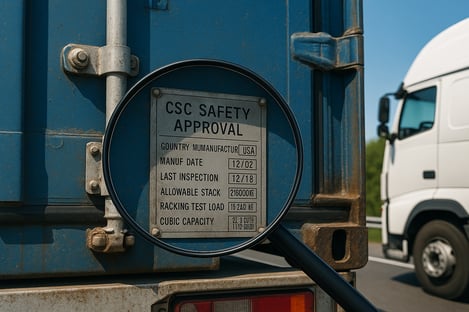What Do the Numbers on a Shipping Container Mean?

If you’ve ever looked closely at a shipping container — on a truck, at the port, or on a worksite — you’ve probably noticed the strings of numbers, letters, and metal plates on the outside. Many of our clients at Conteneurs Experts tell us:
“We see them all the time, but we’ve never really known what they mean.”
We understand how frustrating it can be to buy or use a container without fully understanding its specifications. Whether you’re purchasing a new, used, or modified container, these markings can directly impact your projects.
Here’s a simple guide to help you decode these important numbers.
1. Identification Number (BIC Code)
Example: CEPU 123456 7
This number acts like a global licence plate for each container. It’s made up of three parts:
-
CEPU: the owner’s code (in this example, fictitiously, Conteneurs Experts).

-
123456: the unique serial number assigned to the container.
-
7: a check digit, automatically calculated to verify the validity of the code.
This number is essential for tracking and tracing the container worldwide — it ensures that the container you load in Rotterdam is the same one arriving in Montreal.
2. ISO Code (Dimensions and Type)
Example: 22G1
This international standard code gives two key pieces of information:
-
22:
-
First digit: height (
2= standard, 8'6''). -
Second digit: length (
2= 20 feet).
-
-
G1: type (
G1= dry van standard, a closed non-refrigerated container).
At Conteneurs Experts, many clients choose 45G1 (40-foot High Cube) containers when converting into offices or workshops, thanks to the added interior height.
3. Weight and Capacity Information
Painted on the container doors, you’ll find:
-
MAX GROSS: maximum total weight allowed (container + load).
-
TARE: the container’s empty weight.
-
NET: maximum payload (cargo weight only).
-
CU. CAP: internal capacity, measured in cubic metres or cubic feet.
For a client planning to move the container while loaded, these details are crucial to avoid logistical or structural problems.
4. CSC Plate (Convention for Safe Containers)
This small metal plate (often overlooked) proves that the container meets international safety standards.
It shows:
-
The approving country and authority.
-
The manufacturing date.
-
Inspection results.
-
Maximum stacking capacity and supported loads.
For maritime use, this plate is essential. For fixed projects (like conversions into offices or kiosks), it becomes less critical but still serves as a good quality indicator.
Summary
The markings and plates on a shipping container give you:
-
A unique identification (BIC code).
-
The dimensions and type (ISO code).
-
Maximum weights and volumes (for safe transport).
-
Compliance guarantees (CSC plate).
If you’re buying a non-modified container, knowing the maximum load capacities helps you plan your moves and loadings confidently.
At Conteneurs Experts, we always advise our clients to ensure the final container remains perfectly suited to its intended use.
